Are you a guitarist wondering What Is The Best Acoustic Guitar Strings for your instrument? At guitarplayers.net, we understand that choosing the right strings can dramatically impact your acoustic guitar’s sound and playability, and finding the perfect match is essential for every guitar player, whether they’re just starting their musical journey or are seasoned pros. Let’s dive into the world of acoustic guitar strings, exploring options that enhance tone, improve playability, and cater to your unique playing style to ensure you get the best strings for your guitar.
1. Best Acoustic Guitar Strings: Product Guide
Choosing the right acoustic guitar strings can significantly impact your playing experience. Here’s a breakdown of some of the top strings available, each designed for different needs and preferences, based on expert reviews and player feedback.
1.1. Elixir Nanoweb 80/20 Bronze: Best Overall
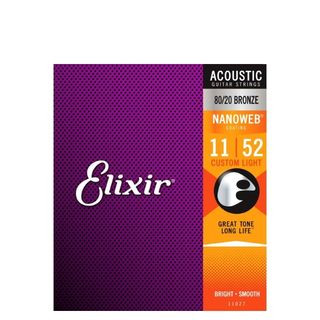 Elixir Nanoweb 80/20 Bronze acoustic guitar strings
Elixir Nanoweb 80/20 Bronze acoustic guitar strings
Alt text: A pack of Elixir Nanoweb 80/20 Bronze acoustic guitar strings featuring a bronze color and a clear Nanoweb coating.
Elixir Nanoweb 80/20 Bronze strings are excellent all-around strings known for their long life and balanced tone.
- Material: 80/20 Bronze
- Coating: Nanoweb
These strings provide a bright, crisp sound that works well in various musical styles. The Nanoweb coating keeps dirt and oil away, extending their lifespan and maintaining consistent sound quality over time. While they may cost more upfront, their durability makes them a worthwhile investment for gigging musicians and players who prefer less frequent string changes.
1.2. D’Addario EJ16 Acoustic: Best for Beginners
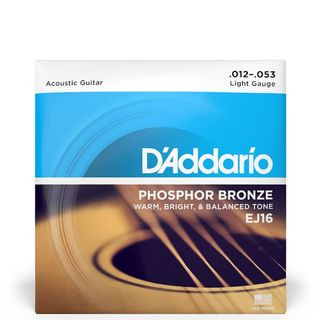 D’Addario EJ16 Acoustic guitar strings
D’Addario EJ16 Acoustic guitar strings
Alt text: A pack of D’Addario EJ16 light gauge acoustic guitar strings showing the brand’s logo and string specifications.
D’Addario EJ16 strings are a popular choice for beginners due to their balanced tone and affordable price.
- Material: Phosphor Bronze
- Coating: N/A
These strings offer a warm, balanced sound suitable for various playing styles. Their light gauge makes them easier on the fingers, which helps beginners develop calluses and proper technique without discomfort. While they may not last as long as coated strings, their affordability makes them easy to replace, ensuring a fresh sound every time.
1.3. Ernie Ball Earthwood: Best Budget
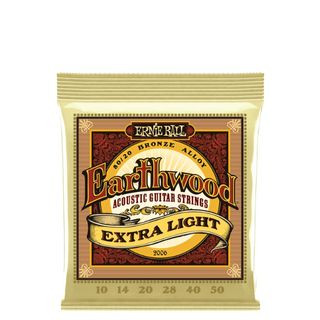 Ernie Ball Earthwood acoustic guitar strings
Ernie Ball Earthwood acoustic guitar strings
Alt text: A package of Ernie Ball Earthwood 80/20 Bronze acoustic guitar strings displaying the Ernie Ball logo.
Ernie Ball Earthwood strings are an excellent option for guitarists on a budget, offering reliable performance without breaking the bank.
- Material: 80/20 Bronze
- Coating: N/A
These strings deliver a bright, balanced tone ideal for various musical styles. Their affordable price makes them accessible to beginners and players who need to change strings frequently. While they may produce more finger squeak than some higher-end strings, their overall sound quality and value make them a solid choice for budget-conscious musicians.
1.4. Martin Retro: Best for Fingerpicking
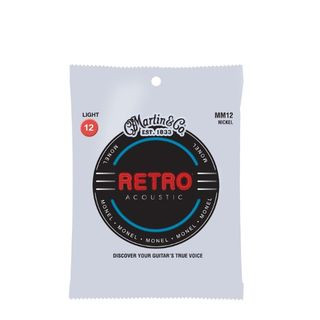 Martin Retro acoustic guitar strings
Martin Retro acoustic guitar strings
Alt text: A pack of Martin Retro monel acoustic guitar strings emphasizing their vintage tone and smooth feel.
Martin Retro strings are designed for fingerpicking, offering a warm, mellow tone that enhances the nuances of fingerstyle playing.
- Material: Nickel/Copper
- Coating: N/A
These strings provide a vintage-inspired sound with reduced harshness and enhanced warmth. Their unique nickel/copper wrap delivers a smooth feel and balanced response, making them ideal for fingerstyle players who want a more intimate, nuanced tone. While they may not be as bright as traditional bronze strings, their warm, mellow sound makes them a favorite among fingerstyle enthusiasts.
1.5. Elixir 12-String: Best for 12-String Guitars
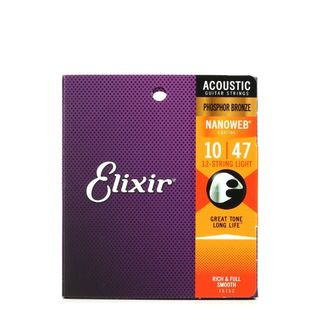 Elixir Nanoweb 12-string acoustic guitar strings
Elixir Nanoweb 12-string acoustic guitar strings
Alt text: A set of Elixir Nanoweb 12-string acoustic guitar strings showcasing their protective coating and extended lifespan.
Elixir 12-String strings provide the long-lasting performance and balanced tone needed for 12-string guitars.
- Material: Phosphor Bronze
- Coating: Nanoweb
These strings offer a bright, balanced sound that enhances the natural resonance of 12-string guitars. The Nanoweb coating keeps dirt and oil away, extending their lifespan and maintaining consistent sound quality over time. While they may cost more upfront, their durability and enhanced tone make them a worthwhile investment for 12-string players who want reliable performance and less frequent string changes.
1.6. D’Addario EJ45 Pro-Arte: Best for Nylon Guitars
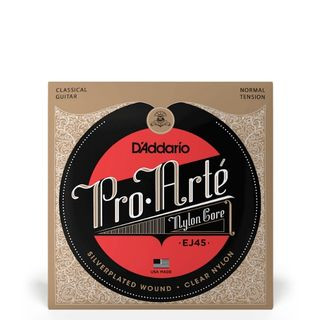 D’Addario EJ45 Pro-Arte nylon guitar strings
D’Addario EJ45 Pro-Arte nylon guitar strings
Alt text: A pack of D’Addario EJ45 Pro-Arte normal tension nylon classical guitar strings with silver-plated wound basses.
D’Addario EJ45 Pro-Arte strings are a top choice for classical guitarists, offering a warm, balanced tone and reliable performance.
- Material: Nylon, Silver-Plated Copper
- Coating: N/A
These strings deliver a clear, articulate sound with balanced tension, making them ideal for classical and fingerstyle playing. Their multi-filament nylon core provides consistent response and warm tone, while the silver-plated copper windings enhance projection and clarity. Whether you’re a beginner or a seasoned player, D’Addario EJ45 Pro-Arte strings offer the quality and performance needed to bring out the best in your nylon-string guitar.
2. Unlocking Acoustic Guitar Strings: Essential FAQs
Understanding the nuances of acoustic guitar strings can greatly enhance your playing experience. Here are some frequently asked questions to help you navigate the world of strings.
2.1. What Is The Best String Gauge For Acoustic Guitars?
The best string gauge depends on your playing style, guitar type, and desired tone. Thicker strings produce a fuller, louder sound with more bass, while thinner strings are easier to play and bend.
String gauge is measured in thousandths of an inch. Sets are typically identified by the gauge of the thinnest string, the high E. For example, a “set of 12s” has a high E string with a .012-inch diameter.
- Thicker Strings: These generally sound fuller and louder with a rounded, bassy low end. They are more durable but can be challenging if you are building strength in your fretting hand.
- Lighter Strings: These are easier to fret and bend, with a brighter sound. The trade-off is losing some deep bottom end.
Consider your guitar’s body size when choosing a gauge. Smaller-bodied guitars may benefit from lighter strings, while dreadnought or jumbo-sized acoustics might pair well with thicker strings. Experiment to find what works best for you.
2.2. Which Acoustic Strings Are Best For Beginners?
For beginner acoustic guitar players, it’s best to use lighter gauge strings, such as Extra Light or Custom Light. These strings are easier on the fingers and require less pressure to fret.
Here are common acoustic guitar string gauges:
| Gauge | E | B | G | D | A | E |
|---|---|---|---|---|---|---|
| Extra Light | .010 | .014 | .023 | .030 | .039 | .047 |
| Custom Light | .011 | .015 | .023 | .032 | .042 | .052 |
| Light | .012 | .016 | .025 | .032 | .042 | .054 |
| Medium | .013 | .017 | .026 | .035 | .045 | .056 |
| Heavy | .014 | .018 | .027 | .039 | .049 | .059 |
Extra Light (.010) and Custom Light (.011) strings provide a bright, punchy tone with low string tension, making them easier to play. As you get more comfortable, you can try heavier strings, but there’s no need to go super heavy unless your style calls for it.
2.3. When Should I Change My Acoustic Guitar Strings?
Knowing when to change your strings depends on how often you play. At a minimum, you should change them every couple of months to keep your guitar sounding its best.
Strings will start to sound and look dull over time. If you use coated strings, they may last longer, but once they lose their spark, it’s time for a change. Regular string changes keep your instrument sounding fresh and vibrant.
2.4. What Are Acoustic Guitar Strings Made Of?
Acoustic guitar strings are commonly made of bronze, phosphor bronze, brass, nickel, silk, and steel.
- Bronze: Offers a bright sound with bell-like clarity and a wide treble-forward frequency response.
- Phosphor Bronze: Phosphor is added to the alloy to slow oxidation, extending string life. These strings sound a little darker and warmer than bronze.
- Brass: Has plenty of top-end jangle.
- Nickel: Has a warmer tone, making them an excellent vintage choice.
- Monel: A nickel-based alloy that many guitarists swear by for getting the best out of their tonewood.
Each material offers its own unique timbre, allowing you to tailor your guitar’s sound to your preferences.
2.5. Are Nylon Guitar Strings Easier To Play?
Yes, nylon guitar strings are generally easier to play. They are referred to as having high or low tension, with low tension strings offering an easier-to-play feel.
Even ‘high’ tension nylon strings have less tension than steel or bronze strings, which is why many people start on a nylon-string classical guitar.
Classical strings have top three strings made from clear or rectified nylon, with the bottom three using bronze or silver-plated copper wire wrapped around a multi-filament core. Only use nylon strings if you have a classical guitar. The difference in tension means that using steel strings on a classical guitar can seriously damage your instrument.
2.6. How Do Coated vs. Uncoated Acoustic Guitar Strings Compare?
Coated and uncoated strings differ significantly in terms of lifespan, tone, and feel. Coated strings have a thin polymer layer that protects the string from dirt, oil, and moisture, extending their lifespan.
- Coated Strings: These last longer and maintain consistent sound quality over time. The coating reduces finger squeak but may slightly dampen the string’s brightness.
- Uncoated Strings: These provide a brighter, more vibrant tone. They offer a more natural feel but require more frequent changing due to quicker degradation.
Coated strings are a great investment for players who want to change strings less often, while uncoated strings are preferred by those who prioritize maximum tonal clarity and a natural feel.
2.7. What Role Does Core Material Play in Acoustic Guitar Strings?
The core material of an acoustic guitar string influences its tone, sustain, and overall feel. Common core materials include steel, nylon, and synthetic composites.
- Steel Core: Provides a bright, crisp tone with excellent projection and sustain. Steel core strings are commonly used in acoustic and electric guitars for their responsive and articulate sound.
- Nylon Core: Offers a warm, mellow tone with enhanced sustain and reduced harshness. Nylon core strings are primarily used in classical guitars for their smooth feel and balanced response.
- Synthetic Composites: These offer a balanced tone with enhanced durability and resistance to environmental factors. Synthetic core strings are often used in modern classical and acoustic guitars for their consistent performance and long lifespan.
Choosing the right core material depends on your desired tone, playing style, and guitar type. Experiment with different core materials to find the sound and feel that best suits your preferences.
2.8. How Do I Choose the Right Acoustic Guitar String Material for My Style?
The material of your acoustic guitar strings affects their sound, durability, and feel. Different materials produce distinct tones that may be more suitable for certain playing styles.
- 80/20 Bronze: These strings offer a bright, crisp tone with excellent projection, making them ideal for strumming and flatpicking.
- Phosphor Bronze: These strings provide a warm, balanced tone with enhanced sustain, making them suitable for fingerstyle and mellow strumming.
- Silk and Steel: These strings deliver a warm, mellow tone with reduced string tension, making them ideal for fingerstyle and vintage-inspired playing.
- Nylon: These strings offer a warm, smooth tone with enhanced sustain, making them perfect for classical and fingerstyle playing.
Consider your playing style and desired tone when choosing the right string material for your acoustic guitar. Experiment with different materials to find the sound and feel that best complements your musical style.
2.9. Can String Tension Affect My Guitar’s Neck?
Yes, string tension can significantly affect your guitar’s neck. Using string gauges that are too heavy for your guitar can cause excessive tension, leading to neck bowing, warping, or even damage.
- Light Gauge Strings: These exert less tension on the neck, making them suitable for vintage or delicate guitars.
- Medium Gauge Strings: These provide a balanced tension that is suitable for most modern acoustic guitars.
- Heavy Gauge Strings: These exert significant tension on the neck and should only be used on guitars specifically designed to handle them.
Always consult your guitar’s manufacturer or a qualified technician before changing to a different string gauge. Proper string tension ensures optimal playability and prevents potential damage to your instrument.
2.10. How Does String Coating Affect Tone and Playability?
String coating affects both the tone and playability of acoustic guitar strings. Coated strings have a thin polymer layer that protects the string from dirt, oil, and moisture, extending their lifespan.
- Tone: Coated strings may sound slightly less bright than uncoated strings initially, but they maintain their tone for a longer period.
- Playability: Coated strings often feel smoother and reduce finger squeak, enhancing playability.
Uncoated strings provide a brighter, more vibrant tone but require more frequent changing due to quicker degradation. The choice between coated and uncoated strings depends on your priorities. If you value longevity and reduced maintenance, coated strings are a good option. If you prioritize maximum tonal clarity and a natural feel, uncoated strings may be preferred.
3. Choosing Acoustic Guitar Strings: A Detailed Guide
Selecting the right acoustic guitar strings involves considering various factors to match your playing style, guitar, and desired sound. Here’s a detailed guide to help you make the best choice.
3.1. Understand String Gauges
String gauge refers to the thickness or diameter of the strings. It’s measured in thousandths of an inch, and sets are usually named after the gauge of the thinnest string (the high E).
- Extra Light (.010-.047): Easiest on the fingers, ideal for beginners and vintage guitars. They produce a bright tone but may lack volume and sustain.
- Custom Light (.011-.052): A bit more volume and sustain than extra light, still easy to play.
- Light (.012-.053): A good balance of playability and tone, suitable for most players.
- Medium (.013-.056): Fuller tone with more volume and sustain, but require more finger strength. Best for advanced players and guitars that can handle the extra tension.
- Heavy (.014-.059): Maximum volume and sustain, but difficult to play. Only suitable for specific playing styles and robust guitars.
3.2. Consider String Material
The material of the strings greatly influences their tone and longevity.
- 80/20 Bronze: Made of 80% copper and 20% zinc, these strings produce a bright, crisp tone with excellent projection. They are ideal for players who want a lively and articulate sound.
- Phosphor Bronze: Made of copper, tin, and a small amount of phosphorus, these strings offer a warmer, more balanced tone with enhanced sustain. They are suitable for various playing styles and musical genres.
- Silk and Steel: These strings have a steel core wrapped with silk and silver-plated copper. They produce a mellow, warm tone with reduced string tension, making them ideal for fingerstyle players and vintage guitars.
- Nylon: Used on classical guitars, nylon strings offer a warm, smooth tone with enhanced sustain. They are easy on the fingers and are perfect for classical and fingerstyle playing.
3.3. Decide Between Coated and Uncoated Strings
Coated strings have a thin polymer layer that protects the string from dirt, oil, and moisture, extending their lifespan.
- Coated Strings: Last longer, maintain consistent tone, and reduce finger squeak.
- Uncoated Strings: Offer a brighter, more vibrant tone and a natural feel, but require more frequent changing.
3.4. Match Strings to Your Guitar
The type of guitar you have can influence the best string choice.
- Dreadnought: This popular body style generally benefits from light or medium gauge phosphor bronze strings for a balanced tone.
- Grand Auditorium: This versatile body style works well with light gauge strings of various materials, depending on the desired tone.
- Parlor: This smaller body style often benefits from extra light or custom light gauge strings to avoid overdriving the top.
- Classical: These guitars require nylon strings designed for their unique construction and playing style.
3.5. Think About Your Playing Style
Your playing style should also influence your string choice.
- Strumming: Medium gauge 80/20 bronze or phosphor bronze strings provide a full, robust sound for strumming chords.
- Fingerpicking: Light gauge phosphor bronze or silk and steel strings offer a warm, articulate tone with enhanced playability for fingerstyle techniques.
- Flatpicking: Medium gauge 80/20 bronze or phosphor bronze strings provide a bright, powerful tone with excellent projection for flatpicking melodies.
3.6. Consider Your Budget
String prices can vary widely, so consider your budget when making a choice.
- Budget-Friendly: Ernie Ball Earthwood and D’Addario EJ16 are affordable options that provide reliable performance.
- Mid-Range: Martin Retro and D’Addario EXP offer enhanced tone and longevity at a moderate price.
- Premium: Elixir Nanoweb provides superior longevity and consistent tone but comes at a higher cost.
3.7. Experiment
The best way to find the right strings is to experiment with different gauges, materials, and brands. Try a few different sets and see how they sound and feel on your guitar. Pay attention to the tone, playability, and longevity of each set.
4. The Science Behind Acoustic Guitar String Selection
Choosing the right acoustic guitar strings involves understanding the physics and material science that affects their sound and playability. Here’s a deeper dive into the factors that make a difference.
4.1. Physics of String Vibration
The frequency at which a string vibrates determines the pitch of the sound it produces. This frequency is influenced by the string’s length, tension, and mass per unit length.
- Length: Shorter strings vibrate at higher frequencies, producing higher pitches.
- Tension: Tighter strings vibrate at higher frequencies, also producing higher pitches.
- Mass: Lighter strings vibrate at higher frequencies, producing higher pitches.
Thicker strings have more mass, so they require more tension to reach the same pitch as thinner strings. This increased tension affects the feel and playability of the strings.
4.2. Material Properties
The material composition of a string affects its density, elasticity, and damping characteristics, all of which influence its tone and sustain.
- Density: Denser materials like steel produce brighter, more resonant tones.
- Elasticity: More elastic materials allow the string to vibrate more freely, enhancing sustain.
- Damping: Materials with high damping coefficients absorb energy from the vibrating string, reducing sustain.
Bronze and phosphor bronze strings have different densities and damping characteristics, which contribute to their distinct tonal qualities.
4.3. Coating Technology
Coating technology affects the string’s lifespan and tonal stability. Polymer coatings like Elixir’s Nanoweb protect the string from corrosion and contamination, extending its useful life.
- Corrosion Resistance: Coatings prevent moisture and contaminants from reaching the string, reducing corrosion and maintaining tonal clarity.
- Friction Reduction: Coatings reduce friction between the string and the frets, enhancing playability and reducing finger squeak.
- Tonal Stability: Coatings help maintain a consistent tone over time by preventing the string from degrading due to environmental factors.
4.4. String Construction
The way a string is constructed also affects its tone and playability. Most acoustic guitar strings have a core wire wrapped with an outer winding.
- Core Material: The core wire can be made of steel, nylon, or synthetic materials, each with its own tonal characteristics.
- Winding Material: The outer winding can be made of bronze, phosphor bronze, silk, or other materials, each with its own tonal and damping properties.
- Winding Pattern: The winding pattern can affect the string’s flexibility and sustain. Tightly wound strings tend to be stiffer and have less sustain, while loosely wound strings are more flexible and have more sustain.
4.5. Environmental Factors
Environmental factors like temperature and humidity can affect string tension and intonation.
- Temperature: Higher temperatures can cause strings to expand, reducing their tension and lowering their pitch.
- Humidity: High humidity can cause strings to absorb moisture, increasing their mass and lowering their pitch.
Players who live in areas with extreme temperature or humidity fluctuations may need to adjust their string tension or intonation more frequently.
5. Expert Tips for Acoustic Guitar String Maintenance
Proper maintenance can extend the life of your acoustic guitar strings and keep them sounding their best. Here are some expert tips for string maintenance.
5.1. Wipe Strings After Playing
Wiping your strings after each playing session removes dirt, oil, and sweat, preventing corrosion and extending their lifespan. Use a clean, dry cloth to wipe down the entire length of each string.
5.2. Store Guitar Properly
Storing your guitar in a case or gig bag when not in use protects it from environmental factors like temperature, humidity, and dust. This helps prevent corrosion and keeps your strings sounding fresh.
5.3. Use String Cleaner
String cleaner products can remove stubborn dirt and oil from your strings, further extending their lifespan. Apply a small amount of string cleaner to a cloth and wipe down each string.
5.4. Change Strings Regularly
Even with proper maintenance, strings will eventually lose their tonal clarity and need to be replaced. As a general rule, change your strings every 1-3 months, depending on how often you play.
5.5. Stretch New Strings
When you install new strings, stretch them properly to stabilize their tuning and prevent them from slipping. Gently pull each string away from the fretboard, then retune and repeat until the string holds its pitch.
5.6. Consider Coated Strings
If you want to minimize maintenance, consider using coated strings. These strings have a thin polymer layer that protects them from corrosion and contamination, extending their lifespan.
5.7. Clean Fretboard Regularly
A clean fretboard helps keep your strings clean and sounding their best. Use a fretboard cleaner product to remove dirt and oil from the fretboard, then condition it with a fretboard oil to prevent it from drying out.
5.8. Check Intonation
Proper intonation ensures that your guitar plays in tune across the entire fretboard. Check your intonation regularly and adjust the bridge saddle positions as needed to maintain accurate pitch.
5.9. Avoid Extreme Temperatures and Humidity
Extreme temperatures and humidity can damage your guitar and strings. Avoid storing your guitar in direct sunlight, near heat sources, or in damp environments.
5.10. Consult a Professional
If you’re unsure about any aspect of string maintenance, consult a qualified guitar technician. They can provide expert advice and perform maintenance tasks like string changes, intonation adjustments, and fretboard cleaning.
6. Innovative Acoustic Guitar Strings: The Future of Sound
As technology advances, innovative acoustic guitar strings are emerging, offering enhanced performance, tone, and longevity. Here are some notable innovations in acoustic guitar string technology.
6.1. Cryogenic Treatment
Cryogenic treatment involves cooling strings to extremely low temperatures to improve their molecular structure. This process enhances their durability, resonance, and tonal clarity.
6.2. Advanced Coating Technology
New coating technologies are creating thinner, more durable coatings that have minimal impact on tone. These coatings provide excellent protection against corrosion and contamination, extending string life.
6.3. Hybrid Materials
Hybrid string materials combine different alloys and polymers to create unique tonal and performance characteristics. These materials offer enhanced sustain, projection, and playability.
6.4. Smart Strings
Smart strings incorporate sensors and microelectronics to provide real-time feedback on string tension, intonation, and playing dynamics. This technology can help players improve their technique and optimize their guitar setup.
6.5. Biodegradable Strings
As environmental awareness grows, biodegradable strings are being developed using sustainable materials. These strings offer comparable performance to traditional strings while reducing their environmental impact.
6.6. Wireless Strings
Wireless strings are a conceptual innovation that would eliminate the need for physical strings altogether. These strings would use electromagnetic fields to simulate string vibration, offering endless possibilities for tonal shaping and expression.
6.7. Self-Tuning Strings
Self-tuning strings incorporate miniature motors and sensors to automatically adjust string tension and maintain perfect intonation. This technology simplifies tuning and ensures consistent performance in any playing situation.
6.8. Personalized String Design
Personalized string design allows players to customize their strings based on their individual playing style, guitar, and tonal preferences. This technology uses algorithms and machine learning to optimize string gauge, material, and construction for each player.
6.9. Augmented Reality Integration
Augmented reality integration overlays digital information onto the physical world, providing players with real-time feedback on their playing technique, string tension, and intonation. This technology can help players improve their skills and optimize their guitar setup.
6.10. AI-Powered String Analysis
AI-powered string analysis uses artificial intelligence to analyze string vibration patterns and provide insights into their tonal characteristics, longevity, and performance. This technology can help players choose the best strings for their needs and optimize their playing technique.
7. How We Choose the Best Acoustic Guitar Strings
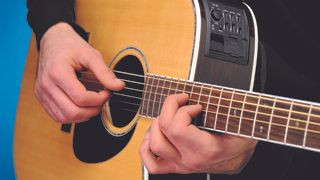 Man playing chord on acoustic guitar
Man playing chord on acoustic guitar
Alt text: A musician expertly plays a chord on an acoustic guitar, showcasing proper finger placement and technique.
When testing acoustic guitar strings, it’s important to evaluate them over time to ensure they’re right for your guitar. The testing process includes:
- Bedding In: Stringing up the guitar with a fresh set and seeing how long it takes for them to stretch and stabilize in their tuning. The best sets will do this in a few hours.
- Feel: Testing how the strings feel under the fingers, looking for smooth strings without imperfections. Coated strings should feel as close to uncoated as possible.
- Corrosion: Leaving the strings on the guitar as long as possible to see when they start to discolor, tarnish, and lose their spark.
- Sound: Listening to how the strings sound through different playing styles, songs, and environments to see how they react and change over time.
8. Ready to Find Your Perfect Strings?
Choosing the best acoustic guitar strings is a personal journey, but with the right knowledge, you can find the perfect match for your playing style and instrument. At guitarplayers.net, we offer a wealth of resources to help you on your musical path.
Explore More at guitarplayers.net:
- Extensive Reviews: Dive into our detailed reviews of various guitar strings to make an informed decision.
- Lessons and Tutorials: Enhance your playing skills with our comprehensive guitar lessons and tutorials.
- Sheet Music: Discover a vast library of sheet music for all genres and skill levels.
- Community Forum: Connect with fellow guitar enthusiasts in our vibrant community forum.
Take Action Now:
- Visit guitarplayers.net: Explore our website for in-depth reviews, lessons, and more.
- Join Our Community: Participate in our forum, share your experiences, and learn from others.
- Contact Us: Have questions? Reach out to us at +1 (617) 747-2261 or visit our address at 1140 Boylston Street, Boston, MA 02215, United States.
Elevate your guitar playing experience today with guitarplayers.net!


